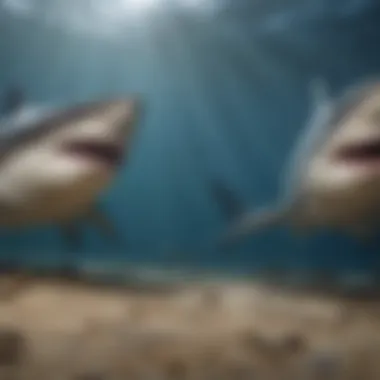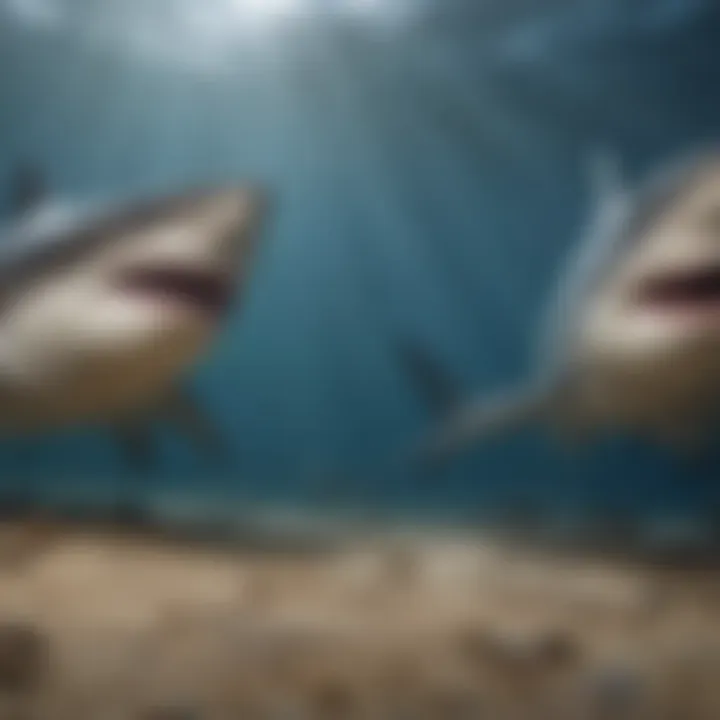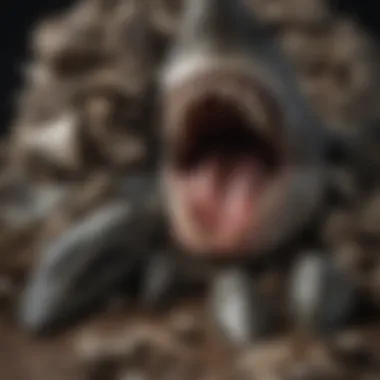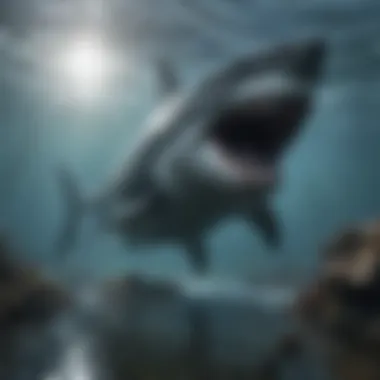Megalodon Size: Insights into a Prehistoric Giant


Nature Topic Overview
In the vast expanse of our oceans, tales of titanic sea creatures swell and surge through time. Among these narratives, the megalodon reigns supreme, captivating the imaginations of both young minds and seasoned scientists alike. This prehistoric shark, often imagined as a gargantuan leviathan, existed around 2.6 million years ago and is touted as one of the largest predators ever to swim in our oceans.
A remarkable aspect of the megalodon that draws interest is its sheer size. The estimates of its length range from 40 to 60 feet, and some exaggerated tales even venture beyond that, sparking excitement and curiosity. Understanding megalodon’s size isn’t just about numbers; it intertwines with its ecological role and its adaptation strategies. This narrative aims to unveil the mysteries behind its dimensions, forging connections with modern sharks and emphasizing the implications of such a size in both its environment and its predator-prey dynamics.
As young readers dive into this exploration, they will discover not just facts but also the stories that make these giants of the ancient seas come alive. Fossils, which serve as windows into the past, reveal the fascinating life history of megalodon, shedding light on growth patterns that paint a vivid picture of its life.
Fun Facts and Trivia
- Did you know megalodon’s teeth could be over 7 inches long? That’s bigger than your hand!
- A megalodon had a bite force estimated to be about 10 times stronger than that of a great white shark. This made it the ultimate predator in its time.
- Fossilized megalodon teeth have been found on beaches around the world, which gives us clues about where they might have lived.
Visuals can enhance this journey. Pictures or visuals of megalodon and comparisons with modern sharks can help kids visualize just how gigantic this ancient creature was.
Wildlife Explorations
Beyond the megalodon, the ocean is home to a myriad of fascinating creatures. For example, the great white shark, a modern relative to the megalodon, exhibits behaviors that mirror some of the ancient shark's predatory tactics. It is known for its remarkable hunting skills and adaptability, much like its long-gone cousin.
Other species that roam in similar habitats include the whale shark, the largest fish in the sea; or the hammerhead, easily recognized by its unique head shape. Here are some fun facts about these creatures:
- The great white shark can grow to over 20 feet long.
- Whale sharks can reach lengths of up to 40 feet and are gentle giants, feeding primarily on plankton.
Engaging features like quizzes can help reinforce these animal facts.
Environmental Awareness
As we learn about megalodon and its size, it’s essential to think about the current state of our oceans. With pollution, overfishing, and climate change affecting marine ecosystems, conservation becomes vital. Young readers can learn about protecting ocean habitats and the creatures that inhabit them.
Here are some ways kids can help:
- Reduce plastic use: Simple acts like carrying reusable bags can make a big impact.
- Participate in beach clean-ups: Making the coastlines cleaner keeps ocean life healthier.
Understanding these actions empowers the next generation to be stewards of our planet, echoing the legacy of ancient giants like the megalodon.
DIY Nature Activities
To spark curiosity further, engaging hands-on activities can be wonderful. Here are some ideas:
- Create a megalodon model: Use clay or cardboard to craft a 3D replica of the megalodon. Encourage kids to research and decorate it based on what they have learned.
- Ocean scavenger hunt: Organize a scavenger hunt with items representing different sea species, including sharks, fish, and sea turtles.
- Nature journals: Encourage children to keep a nature journal, drawing or noting different sea animals they learn about, adding a personal touch to their learning.
By blending facts with creativity, the mysteries of the ocean can seam to leap off the page.
"With each discovery, we dive deeper into a world that has captivated our hearts and minds for centuries. The story of the megalodon is just the beginning of our oceanic adventure."
Through these explorations, children will not only enhance their knowledge of megalodon but cultivate a genuine interest in marine biology and the preservation of our planet.
Preamble to Megalodon
In the realm of prehistoric giants, few creatures capture the imagination like the Megalodon. This extraordinary predator isn't just a topic of curiosity; it serves as a window into a prehistoric world that faced unique challenges and conditions. Understanding Megalodon can shine a light on not only its size but also its role within the ocean's intricate ecosystem. Children, parents, and educators alike find this topic fascinating because it offers a blend of storytelling from the past and scientific inquiry.
By uncovering the secrets of the Megalodon, we can appreciate the sheer scale and power of this ancient shark. It invites questions like: How did it grow so large? What did it eat? How did it fit into its environment? These inquiries boost critical thinking skills in young minds and allow for meaningful discussions between generations. Moreover, this knowledge holds relevance in today’s studies on marine biology and conservation, drawing parallels between past and present.
What is a Megalodon?
Megalodon is often described as one of the largest and most formidable sharks ever to roam the oceans. The term "Megalodon" comes from the Greek language, meaning "big tooth." Indeed, its teeth are a significant aspect of what makes this creature so memorable, with some specimens measuring over seven inches long. Imagine that—a tooth larger than an adult's hand. It’s no wonder that these teeth are the primary fossils found that provide evidence of Megalodon's existence.
Megalodon is believed to have lived around 23 to 3.6 million years ago during the Cenozoic Era. It thrived across the world’s oceans, adapting to various marine environments. With its massive size and power, this predator targeted large prey, including whales and other marine mammals. The sheer scale of this shark makes it a subject of awe and fascination for those who learn about it.
The Era of the Megalodon
The Megalodon swam the waters during a time when the Earth’s climate was markedly different. This era, often called the Miocene Epoch, saw a dynamic oceanic landscape filled with abundant marine life. In contrast to what we see today, the oceans were a bustling playground full of diverse creatures, including large fish and majestic whales that Megalodon could prey upon.
The conditions then provided the perfect huntin grounds for Megalodon. Warmer waters and a diet rich in high-energy prey contributed to its impressive growth and size. However, the tidal shifts of environmental change that characterizes this period also sets the stage for the story of Megalodon—one filled with challenges that eventually led to its decline.
Megalodon exemplifies how life adapts but also how vulnerable a species can be to the changing tides of nature. An understanding of this context enriches our comprehension of not just the Megalodon but also the interconnectedness of ecosystems, making it vital for learners and future caretakers of our planet.
Estimating Size Through Fossils
Estimating the size of the megalodon largely relies on fossil evidence. Fossils serve as the remnants of ancient life, providing a window into the past. To gauge megalodon's immense scale, paleontologists analyze various fossils that offer critical clues about its size and biology. This meticulous process not only involves examining what remains but also interpreting these clues to make educated estimations about this brutal predator.
Through fossil evaluations, scientists can piece together an understanding of how these massive creatures once roamed the oceans. By doing so, it's easier to understand not just their size, but their ecological role within the marine world of their time. Precise estimations can relate the data found to existing modern species, helping put the megalodon into perspective, so readers can grasp its true enormity.


Fossil Evidence Overview
Fossil evidence plays a crucial role in estimating the size of the megalodon. The most notable remain you might think of is teeth, which are commonly found and easily recognizable. These sharp, serrated teeth tell a tale about the diet and hunting techniques of this fierce predator. Fossilized vertebrae and jaw structures also provide insights into the overall size and shape of megalodon. Together, these elements create a clearer picture of the megalodon's life in ancient oceans.
Types of Fossils Used
Teeth
Teeth are perhaps the most quintessential aspect when studying megalodon. They can measure nearly seven inches in length and are characterized by their serrated edges, adapted for gripping and tearing flesh. These fossils are a popular choice for paleontologists because their durability allows them to withstand the test of time, making them one of the most common finds. Besides sheer size, a unique feature of megalodon teeth is that they can hold a lot of information; the tooth structure often reflects its growth stages, revealing how quickly these creatures matured.
However, while teeth provide a wealth of information, they only offer a limited view of the creature’s total size and shape. Relying solely on teeth for size estimation can sometimes lead to misinterpretation.
Vertebrae
Vertebrae play a significant role in understanding megalodon’s size and anatomy. These bones form the backbone and can give insights into the creature’s overall length and mass. They are beneficial tools for paleontologists, as they could align and extrapolate the entire skeletal framework from well-preserved vertebrae. Megalodon vertebrae differ tremendously from those of modern sharks, emphasizing its substantial body mass and structure.
Nevertheless, vertebrae can be challenging to find in their complete form. Broken or incomplete vertebrae may lead to ambiguity in size estimations.
Jaw Structures
Understanding the jaw structures of megalodon sheds light on its feeding habits and size. The jaws of megalodon were enormous, potentially spanning up to ten feet across. Their structure suggests powerful muscles capable of delivering a jaw pressure that would crush bones. This makes them a valuable element of the fossil record. The jaw bone can reveal crucial aspects about how they hunted and what prey they targeted, thus indirectly reflecting their size.
On the other hand, locating complete jaw structures can be rare. Incomplete fossils may not provide a full representation of the megalodon’s capabilities. Missing pieces could lead to skewed interpretations of its hunting prowess.
Growth Patterns of Megalodon
Understanding the growth patterns of the megalodon provides useful insight into both its size and its place in the oceanic ecosystem. Analyzing how these ancient giants transitioned from small juveniles to colossal adults not only deepens our grasp of their biology but also informs us about their behavior, predatory strategies, and interactions with other species in prehistory. These aspects help to piece together the environmental conditions that facilitated their enormous growth and dominance in the oceans.
Juvenile to Adult Transition
Megalodon's life began quite differently than what most of us envision when we think of this shark. At the juvenile stage, these creatures were much smaller—around the size of a human. In a predator's world, this early phase is crucial. Young megalodons had to navigate and survive in an ecosystem where larger marine animals were plentiful and threats lurked everywhere. Harsh as it sounds, many young sharks faced high mortality rates.
However, their growth trajectory was remarkable. Megalodon juveniles had rapid growth rates, possibly fueled by a diet rich in smaller fish and marine mammals. As they transitioned into adulthood, their diets expanded to include larger prey, reinforcing their position as apex predators. This drastic size increase meant that megalodons could capitalize on various marine ecosystems, adapting their hunting strategies as they grew larger.
The growth phase from juvenile to adult lasted several years, during which they could reach lengths exceeding 30 feet. Interestingly, recent studies suggest that megalodons may have shared traits with modern sharks when it comes to growth. For instance, their growth patterns followed a similar curve to that seen in current-day great white sharks but on a much grander scale.
Growth Rate Comparisons
Modern Sharks
Looking at modern sharks gives us a frame of reference to understand how megalodons grew. Great white sharks, for example, are noted for their formidable growth rates. They can grow approximately 1-2 feet each year during their early years, eventually reaching around 15 to 20 feet in length. In the case of megalodons, their growth rates might have surpassed this, making them a standout in the evolutionary story of sharks.
One of the key characteristics of modern sharks is their robust physiological adaptations. By studying these traits, we can theorize that megalodons likely had similar abilities to maximize their energy for growth. Their body structure—streamlined and powerful—could have allowed for even more efficient hunting and metabolism.
Despite the advantages of studying modern sharks, one must exercise caution. There are substantial differences; modern sharks adapt to different ecosystems and face various prey and competition. Thus, while comparisons are valuable, we must remember that megalodons operated in a world vastly different from today’s waters.
Bony Fish
On the other hand, studying bony fish provides another dimension in analyzing growth patterns. Many species of bony fish also demonstrate remarkable growth. Some can grow several inches within weeks, depending on available food resources and environmental factors.
One key aspect of bony fish is their adaptability. They often thrive in various marine environments, competing for food and territory. The ability of bony fish to change their habitats and dietary habits can help paint a picture of how megalodons adapted as they grew. They likely fed on various bony fish, maximizing their growth potential before moving on to larger prey.
In focusing on growth comparisons, bony fish illustrate the interconnectedness of marine life. While at first glance they may not appear similar to megalodons, the food web in ancient oceans was complex. Bony fish served as prey for young megalodons, creating an important balancing act in marine ecosystems.
Thus, the interplay between megalodons and bony fish contributes significantly to our understanding of growth dynamics and the overall marine landscape during their reign.
The growth of megalodon exemplifies how apex predators can reshape their environments while adapting to the challenges of their ecosystems.
In summation, growth patterns offer a fascinating glimpse into the life of megalodon. By comparing their juvenile stages to modern sharks and the roles of bony fish, one can appreciate the complex interdependencies within marine ecosystems that allowed the megalodon to thrive during its time.
Comparative Size Analysis
Understanding the size of the Megalodon in relation to other sharks is crucial for grasping its significance in prehistoric marine ecosystems. Comparing the giants of the ocean helps illustrate the sheer scale of the Megalodon and places it in context within the lineage of sharks. By examining its size in relation to species like the Great White Shark and others, we can appreciate its role as a dominant predator and how it might have affected marine life during its time. This comparative lens also sheds light on evolutionary changes in size among predatory fish, revealing which traits may have been advantageous.
Megalodon vs. Great White Shark
To begin with, when discussing the Megalodon, it’s impossible to bypass the Great White Shark, its closest modern relative. The Megalodon, known scientifically as Carcharocles megalodon, measured up to 60 feet long, towering over the average Great White, which maxes out around 20 feet. To visualize this, think of three adult school buses stacked end to end—that’s the size difference we're talking about!
The sheer bulk of the Megalodon meant that it occupied a completely different ecological niche. With its massive jaws filled with serrated teeth, it was perfectly designed to handle the robust bodies of large marine mammals like whales and giant fish. This contrasts with the Great White, which typically feeds on seals and smaller fish. The varying diets reflect their size disparity and illuminate how evolutionary paths diverged even amongst closely related species.
Megalodon and Other Predatory Sharks


When putting the Megalodon up against other notorious sharks, one has to look at both the Tiger Shark and Whale Shark.
Tiger Shark
With a reputation for its tenacity, the Tiger Shark is a fascinating figure in the shark world. Growing up to 16 feet, this shark is notably smaller than the Megalodon. However, it's often regarded as one of the ocean's best-survivors due to its diverse diet, which includes almost anything it comes across. This adaptability is a key characteristic.
Moreover, the Tiger Shark's unique feature is its distinct striped pattern—much like a tiger—which it retains into adulthood. This helps it blend into the ocean environment, making it a skilled ambush predator. In the context of the overall size discussion, studying the Tiger Shark’s flexibility in diet also offers insights into how different sizes adapt to varying ecological roles, making it a beneficial comparison point alongside the Megalodon.
Whale Shark
Unlike the Tiger Shark, the Whale Shark, the largest fish in the sea, grows to about 40 feet long. Whale Sharks are filter feeders, primarily consuming plankton and small fish. Their immense size is a remarkable adaptation, allowing them to take advantage of nutrient-rich waters.
What sets the Whale Shark apart is its peaceful demeanor and unique pattern of spots. This peaceful characteristic sharply contrasts the Megalodon, which was a voracious predator. The Whale Shark’s size represents another evolutionary path that showcases how different species can thrive in their environments, providing a broader understanding of size influence within ocean ecosystems.
As we dive deeper into these comparisons, we not only highlight the differences in size and feeding strategies but also appreciate the varied roles sharks play in marine life.
Through these analyses, we can provoke a discussion about the environmental implications that come with such stark size differences. This illuminating aspect can engage readers, prompting them to wonder how these predators shaped the world beneath the waves.
Ecological Role of Megalodon
The ecological role of the megalodon holds significant relevance in understanding this ancient predator's existence and its environment. It was not just a giant fish swimming around; it was a keystone species. This means it had a crucial part in maintaining the balance of its ecosystem. As the apex predator of its time, it played a pivotal role in the food chain by regulating the populations of other species. By keeping certain prey numbers in check, the megalodon contributed to the overall health of marine habitats.
Predation and Food Web
Megalodon was the big boss of the oceanic food web. Its eating habits influenced the distribution and dynamics of various prey species. Focusing on larger marine mammals, it targeted creatures like whales and large fish, affecting their populations. The predatory behavior reflected a typical pattern in ecosystems where top predators maintain the balance among prey species. This relationship is fundamental in ecological studies as it shows how different species interact to create a functioning ecosystem.
Impact on Prey Species
Marine Mammals
Marine mammals represent a vital part of the megalodon's diet. Their key characteristic is their size and mobility, which made them considerable targets for such a formidable predator. These animals, including species like the early ancestors of whales, experienced pressure from the megalodon's feeding habits. This predation affected their population dynamics and behaviors, leading to adaptations over time.
The unique feature here is the evolutionary arms race that likely occurred due to the presence of such a predator. Marine mammals that could evade or survive megalodon attacks may have gained evolutionary advantages, which can be fascinating when studying evolutionary biology. Understanding these interactions helps us appreciate how the megalodon influenced marine ecosystems far beyond just its sheer size.
Fish Populations
Fish populations also played an essential role in the megalodon’s ecological footprint. The megalodon’s presence ensured that certain fish species thrived while others were kept in check. This phenomenon highlights the key characteristic of diverse diets that many apex predators possess. They are not just picky eaters; they help maintain a balanced marine environment.
A unique aspect of fish populations in the megalodon’s time is their variety. The predator likely targeted different species based on size and availability, showcasing the flexibility in its feeding strategies. This adaptability allowed the megalodon to thrive in various marine environments, shaping fish populations significantly.
Megalodon's predatory nature created a ripple effect within its ecosystem; its presence was both a regulator and a catalyst for change.
As researchers continue to study ancient ecosystems, the megalodon remains a crucial focal point, linking our understanding of current marine life to a distant past.
Megalodon in Popular Culture
The fascination with the megalodon extends far beyond its mammoth size and prehistoric existence; it has carved a niche for itself within our cultural zeitgeist. From films and documentaries to books, the megalodon embodies the ultimate predator, drawing connections between our primal fears and the mysteries of the oceans. The way it has been represented in various media not only entertains but also allows for the exploration of its scientific significance and the mythos that surrounds these immense creatures.
Fiction and Media Portrayals
When it comes to popular images of the megalodon, movies reign supreme. Films such as "The Meg" portray this prehistoric shark as a lurking menace, creating suspense and thrilling audiences around the globe. It's a slippery slope, blurring the lines between fact and fiction.
- Dramatic Encounters: These films often exaggerate the size and ferocity of the megalodon for entertainment. The reality, however, reflects a creature that, while fearsome, likely played a different ecological role than monster films suggest.
- Education through Entertainment: Documentaries about megalodon, like those from the BBC or National Geographic, provide insight backed by scientific research. Though dramatization exists, they often balance the suspenseful elements with educational narratives, letting viewers sip from the cup of both fear and knowledge.
Such portrayals serve to ignite curiosity, pushing people to explore the real science behind these fascinating creatures instead of taking everything at face value.
Myth vs. Reality
As with many legendary creatures, the megalodon is subject to myth-making. It's common for information to get lost in translation; the big fish tale grows with every telling. Understanding the balance between myth and reality helps to demystify what we know about this ancient shark.
"While the megalodon might swim in the same waters of the imagination as dragons and unicorns, its existence is firmly anchored in reality."
- Real Facts: The megalodon lived roughly 23 to 3.6 million years ago, its teeth discovered worldwide leading paleontologists to speculate its actual size and predatory behaviors.
- Misconceptions: Some myths have endured, such as the belief that megalodon could still inhabit the oceans today. Scientific evidence indicates that such a creature faced extinction due to a combination of environmental shifts and competition for resources.
These narratives in popular culture, while sometimes misleading, also serve a greater purpose. They can spark interest and lead young audiences to discover not only the truth about the megalodon but a broader understanding of marine biology and extinct ecosystems, making education engaging and inspiring.
The Fate of the Megalodon
The fate of the megalodon is not just a tale of extinction; it’s a window into how environmental changes can influence species survival. Understanding what happened to this gigantic predator can help us learn about the fragility of the ocean life today. This part of the article delves into various extinction theories and the last known presence of megalodon, giving perspective on both its rise and fall in the prehistoric world.
Extinction Theories


Several theories attempt to explain why the megalodon vanished while its relatives seemed to thrive. These ideas help illustrate the changing world in which megalodon once lived.
- Climate Change: One of the sticking points in the survival of many marine species. As the Earth cooled during the late Miocene and Pliocene epochs, sea temperatures dropped. For a top predator like megalodon, which thrived in warmer waters, this could have posed serious challenges for survival. A sudden drop in temperature would have affected the distribution of prey species and may have led to the megalodon's decline.
- Competition: The rise of other marine predators such as the great white shark might have played a role too. As these sharks evolved and became more abundant, they likely competed with the megalodon for the same food source. It’s like trying to eat the last piece of cake at a party, only to find more people than cake!
- Decreased Food Supply: Megalodon primarily preyed on large marine mammals. As coastal ecosystems changed, the availability of these mammals might have diminished. If it couldn't find enough to eat, not much chance would be left for sustaining such a colossal creature.
Whatever the reason, these theories link closely to the ever-changing environment of the ocean—an environment that demands adaptation or leads to extinction.
Last Known Presence
Determining when megalodon was last seen is no easy task. Fossils tell us many things, yet the puzzle remains incomplete.
Most fossil evidence suggests that megalodon existed until around 2.6 million years ago, which coincides with the onset of the Pleistocene epoch that brought significant climatic changes. Fossils of megalodon teeth found in various locations, including the U.S. east coast and parts of Europe, indicate they once roamed these waters in large numbers.
To piece it together:
- Fossil Record: Most teeth discovered were from the late Miocene to early Pliocene. However, occasional finds in late Pliocene deposits hint that they might have lingered on longer than previously thought.
- Ecological Shift: As the ecological web changed with the cooling waters, signs indicate a decline in megalodon's food sources as described before. With less to eat, the mighty hunter would eventually fade from the seas, leaving behind only teeth as evidence of its once-great presence.
"Although we may never pinpoint the exact moment the last megalodon took its final swim, the pieces illustrate a vivid image of how interconnected life is in the oceans."
In summary, the extinction of megalodon serves as a cautionary tale. It’s not just about a fish gone; it’s about the lessons we can take from its incredible size and eventual decline. Every large predator is a piece of a complex puzzle, reminding us of how fragile life can be, especially in a world where change is the only constant.
Scientific Research on Megalodon
Understanding the size and biology of the megalodon isn't just about curiosity. It has critical implications for both science and our understanding of marine environments. The megalodon, as a former apex predator, played a vital role in its ecosystem and its extinction raises questions about changes in ocean life over the millennia. Investigating megalodon research helps scientists piece together marine ecosystems' history, shedding light on how predators and prey interact within a habitat.
Ongoing Studies
Research on the megalodon is not a thing of the past. Here are some key areas researchers are currently focused on:
- Genetic Studies: Scientists are examining the genetic material of modern sharks to find connections and learn more about the megalodon’s lineage.
- Paleoenvironmental Analysis: Understanding the conditions of the ocean during the megalodon’s time helps paint a picture of how it thrived in its habitat.
- Digital Reconstructions: Some researchers are using advanced technology to create digital models of megalodon anatomy from fossil evidence, allowing for more precise estimations of its size and capabilities.
These studies are pivotal in uncovering the biological and ecological aspects of a creature that ruled the seas.
Future Discoveries Predicted
What could the future hold for our understanding of megalodon? Here are predictions about future discoveries:
- New Fossil Finds: As excavations continue, more fossils may surface. Each new find has the potential to change previously held beliefs about size and behavior.
- Climate Impact Research: Greater knowledge about ancient climates may reveal how environmental changes affected megalodon populations.
- Comparative Behavior Studies: Insights into how similarly sized sharks behave today could shed light on the possible hunting and migration patterns of megalodon.
Ongoing efforts and future predictions promise a deeper understanding of this extraordinary creature, enriching not only our knowledge of megalodon but marine life in general.
"The study of megalodon is not just about a giant shark; it's about unlocking narratives of life, extinction, and evolution in our oceans."
This scientific exploration not only fuels intrigue but is instrumental in educating future generations about the magnificence and importance of marine life.
Ending: The Legacy of the Megalodon
Megalodon's legacy stretches beyond its massive size and predatory prowess. The fascination with this ancient shark highlights our ongoing curiosity about the natural world and its remarkable creatures. As we wrap up our exploration of the Megalodon, we uncover the multifaceted significance of this giant predator in various contexts.
First and foremost, the sheer size of the Megalodon continues to captivate the imagination of many, stirring a sense of wonder and adventure. Children and adults alike find themselves captivated by stories, documentaries, and movies featuring this gigantic shark, often illustrating the epic battles between nature’s largest hunters. As such, it becomes a crucial element in fostering a love for marine biology and ecology among young audiences. Understanding how such a creature once ruled the oceans can inspire future generations to appreciate marine life and protect it.
Moreover, the Megalodon serves as a powerful symbol of ecological balance. This apex predator played a key role in regulating fish populations and maintaining the health of its ecosystem. Studying its interactions within its environment provides insights into the importance of biodiversity and the consequences that can arise from losing top predators. The extinction of the Megalodon reminds us of the delicate balance nature maintains, prompting discussions about conservation efforts and habitat preservation today.
"Learning about creatures like the Megalodon deepens our understanding of Earth’s history and teaches us valuable lessons about respecting our environment."
In a more intricate sense, the Megalodon highlights the evolution of species and the remarkable adaptability of life over millions of years. By examining its rise and fall, we gather important clues about how today's sharks adapt to their environment and face ongoing challenges, such as climate change. Not only does it allow scientists to assess historical trends, but it also offers a glimpse of potential futures for our marine ecosystems.
In shorter terms, the legacy of Megalodon is rich with educational potential. By sparking a sense of wonder and responsible stewardship towards oceans, it paves the way for meaningful conversations about our planet’s biodiversity and the roles that apex predators play.
Enduring Fascination with Size
The enduring fascination with size captures the hearts of many young enthusiasts. Children often revel in stories of gigantic creatures, from dinosaurs to colossal megalodons. The idea that a shark could grow to lengths exceeding that of a school bus is simply mind-boggling.
To further explore this sense of wonder, consider how Megalodon size compares with familiar objects:
- A classroom: Picture a 60-foot-long shark swimming around it, easily fitting inside.
- A blue whale: Although the blue whale is larger, Megalodon dwarfs many other sharks, making it a standout.
- A small car: At some estimates, Megalodon could be twice as long as a compact car.
Such comparisons make the concept of size relatable and emphasize just how remarkable and awe-inspiring the Megalodon truly is.
Through books, films, and museum exhibits, the Megalodon's monumental stature continues to spark interest. It encourages kids to ask questions, explore their curiosities, and engage with science, fostering an inclusive environment for learning.
Lessons from Nature’s Apex Predators
The Megalodon serves as a poignant reminder of the lessons we can learn from apex predators in nature. Despite its extinction, the Megalodon provides insight into the essential role such creatures play in their ecosystems. Apex predators maintain the stability of their environment, help control prey populations, and facilitate a healthy ecosystem balance.
Some lessons include:
- Ecological Responsibility: Understanding that every creature has a role reinforces the importance of protecting our environment.
- Adaptability: Sharks today, like the Great White, exhibit traits that have helped them survive, drawing parallels to the adaptability of the Megalodon in its time.
- Conservation Awareness: Learning how the loss of one species can impact the wider ecosystem urges discussions on conservation efforts.
In this way, Megalodon inspires not just curiosity about the past, but also a proactive mindset about our place in the natural world today. The fascination with this creature's size and power instills a sense of responsibility toward all living beings that inhabit our planet.







